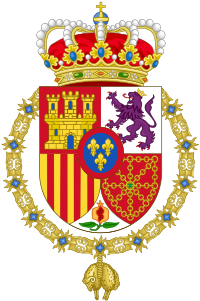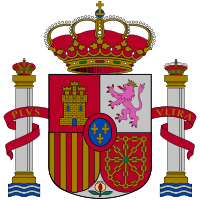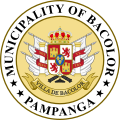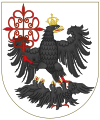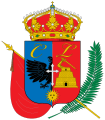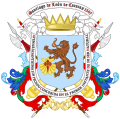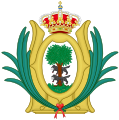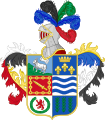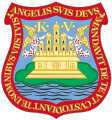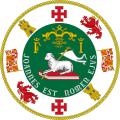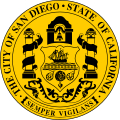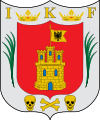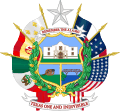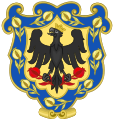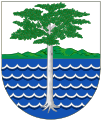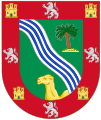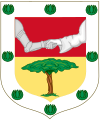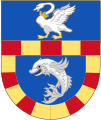Spanish heraldry facts for kids
Imagine a time when knights wore heavy armor, covering them from head to toe. How could anyone tell who was who on the battlefield or in a jousting tournament? That's where heraldry came in! It's the art of designing and using special symbols, like those on a coat of arms, to identify people, families, or groups. In Spain, this tradition started around the 11th century, just like in other European countries. It was super important for knights and nobles to have their own unique symbols so everyone could recognize them.
Contents
What are Coats of Arms Like?
The design of a coat of arms was usually up to the owner, and often, the symbols had a special meaning. At first, anyone could have a coat of arms. But over time, it became more common for noble families.
In the past, only the father's family symbols were used. Later, both the father's and mother's family symbols were shown together. This was done by cutting the shield in half vertically and showing each family's symbols on one side. By the 18th and 19th centuries, noble families started using four sections on their shields. Each section would show the symbols of one of their grandparents.
The usual order for these sections was:
- Your father's father
- Your mother's father
- Your father's mother
- Your mother's mother
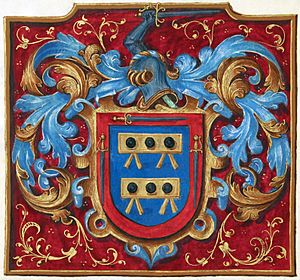
How Spanish Heraldry Began
Unlike noble families in other parts of Europe, Spanish nobles usually earned their rank through military service. It was rare for families to become noble through law, business, or the church. Many great families in Spain and Portugal became important and wealthy because of their brave actions in battles. This meant that even common people could become nobles if they served the military loyally and successfully.
In Spanish heraldry, a coat of arms is more than just a symbol; it represents a family's history and lineage. Spanish coats of arms can be passed down through generations, just like other family property.
How Spanish Arms are Passed Down

One interesting thing about Spanish coats of arms and noble titles is that they can be inherited through females. This was different from many other parts of Europe. Also, in Spain, being born outside of marriage did not always stop someone from inheriting arms and titles. Important Spanish families believed that a family's history could be more harmed by marrying someone from a lower social class than by having a child outside of marriage. In fact, some noble families even made plans for their coats of arms to go to children born outside of marriage if there were no other heirs.
Style and Look
Spanish heraldry has its own special style, similar to Portuguese heraldry. The most common shape for a shield in Spain is the "Iberian" style, which is square at the top and round at the bottom. The pictures and symbols on Spanish coats of arms often show historical events or brave deeds from wars. They also often have special borders around the edge of the shield.
Unlike in northern Europe, Spanish and Portuguese heraldry sometimes allows words and letters to be placed right on the shield. While fancy crests (symbols placed above the helmet) are common in Portugal, they are less common in Spain. Instead, Spanish helmets often have feathers on top.
What Do Parts of a Coat of Arms Mean?

In Spain, a complete "coat of arms" (or "achievement") includes the shield, a cape (which can be simple or fancy), a helmet (sometimes), or a crown if the person is noble, and sometimes a family motto. The most important part in Spanish heraldry is what is shown on the shield itself.
In English, Scottish, and Irish heraldry, you might see many more extra parts that are not often used in Spanish heraldry. These can include things like a helmet, a cloth cape (mantling), a wreath, a crest, a motto, special hats, supporters (animals or people holding up the shield), the ground the supporters stand on, flags, crowns of rank, and badges from special orders. Generally, the older a coat of arms is, the simpler it looks.
Images for kids
-
Sovereign – Royal Crown of Spain
Design of the monarch's arms -
Sovereign – Variant for the Spanish Territories of the former Crown of Aragon
-
Infantes – Variant for the Spanish Territories of the former Crown of Aragon
-
Heraldic Coronet of Spanish Grandee
-
Brigadier General Counter Admiral
Rules for Heraldry
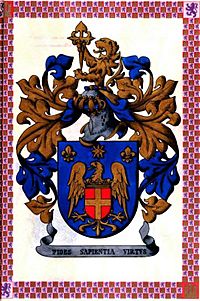
In Spain, there used to be special government officials called "Chronicler King of Arms" (Cronista de Armas). These officials had the power to officially grant coats of arms. This job came from older officials called heralds, who were originally in charge of organizing tournaments and delivering messages between nobles.
In the early days of heraldry, anyone could use a coat of arms. But sometimes, people or families would argue over who had the right to use certain symbols. The King would settle these arguments, or a lower official would if common people were involved. Eventually, this job went to the heralds.
The Spanish Cronista de Armas office has been around since the 16th century. These officials had legal powers over noble titles and also checked family histories and grants of arms. While these jobs were not meant to be passed down in families, many times they were, going from father to son.
Today, the government of Castile and León has appointed Don Alfonso Ceballos-Escalera y Gil as the Chronicler of Arms for their region. He is also a personal heraldic officer to the King of Spain. He has the authority to grant coats of arms to Spanish citizens and people from families connected to Spain's former colonies.
National and City Coats of Arms
Just like most countries, Spain has its own national coat of arms. Many cities also have their own coats of arms. Some are new, while others are very old, dating back to the medieval times.
Toledo, which was once a very important city in Spain, has a very detailed coat of arms. It uses a double-headed eagle as a supporter (something holding up the shield), which shows how important and powerful the city used to be. Madrid, the capital city, has a simpler coat of arms that shows a bear reaching for fruit on a tree.
You can see coats of arms everywhere in Spain, on government buildings and even on things like manhole covers in Madrid!
Personal Coats of Arms
Some very old Spanish families have their own personal coats of arms. For example, the Dukes of Alba, who were historically one of the most powerful noble families in Europe, have a very detailed coat of arms. It includes symbols of "justice" because they held an important inherited position as Constables of Navarre. The King and the heir to the throne also have their own personal coats of arms.
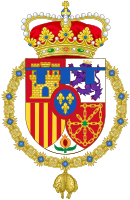
In Spain, rules for coats of arms are in place, and it's against the law to use a coat of arms that belongs to someone else.
Spanish coats of arms are divided in ways similar to those in other European countries. When new branches of a family were formed, they often combined different coats of arms into one. This is why Spanish shields are often divided into sections.
In Spain, there wasn't a special rule that women had to use a different shape (like a diamond) for their coats of arms. Both men and women inherited a coat of arms from their fathers. Women could also choose to use their husband's coat of arms.
Colors and Metals
| Color/Metal | Heraldry Name | Spanish Name |
|---|---|---|
| Metals | ||
| Gold/Yellow | Or | Oro |
| Silver/White | Argent | Argén or Plata |
| Colors | ||
| Blue | Azure | Azur or Azul |
| Red | Gules | Gules or Rojo |
| Purple | Purpure | Púrpura |
| Black | Sable | Sable or Negro |
| Green | Vert | Sinople or Verde |
Spanish Heraldry Around the World
Today
-
Municipal Seal of
Bacolor, Pampanga
(Philippines) -
Coat of Arms of
Baja California Sur
(Mexico) -
Early Coat of Arms of Buenos Aires
(Argentina) -
Coat of Arms of Durango
(Mexico) -
Coat of Arms of Guadalajara
(Mexico) -
Coat of Arms of Guatemala City
(Guatemala) -
Coat of arms of Lima
(Peru) -
Arms of
Los Angeles
(United States) -
Coat of Arms of Malabo
(Equatorial Guinea) -
Arms of the Seal of Manila
(Philippines) -
Coat of Arms of Medellín
(Colombia) -
Coat of arms of
Mexico City
(Mexico) -
Coat of Arms of
Panama City
(Panama) -
Coat of Arms of Potosí
(Bolivia) -
Coat of Arms of
Puebla City
(Mexico) -
Coat of Arms of
Puerto Rico -
Coat of Arms of
Puerto Rico
(Aragonese Arms Variant) -
Great Seal of
Puerto Rico -
Coat of Arms of
S. Antonio
(United States) -
Coat of Arms of Seal of
St. Augustine
(United States) -
Coat of arms of San Germán
(Puerto Rico) -
Coat of Arms of Seal of
St. Johns County
(United States) -
Seal of San Diego
(United States) -
Coat of Arms of
San Juan City
(Puerto Rico) -
Coat of Arms of Santiago
(Chile) -
Coat of Arms of
Santo Domingo
(Dominican Republic) -
Reverse of the Seal of Texas
(United States)
From History
Spanish Empire
-
Coat of Arms of
the Californias -
Coat of Arms of
Cartagena of the Indies -
Coat of Arms of the Spanish Colony of Cuba
-
Coat of Arms of Cusco
-
Coat of Arms of Guatemala City and Antigua
-
Coat of Arms of
Nueva Galicia -
Coat of Arms of Yucatan
Overseas Provinces
-
Coat of Arms of
Spanish Guinea -
Coat of Arms of
Spanish Sahara
Spanish West Africa -
Coat of Arms of
Fernando Po Province
Spanish Guinea -
Coat of Arms of
Río Muni Province
Spanish Guinea -
Coat of Arms of
Santa Isabel City
Spanish Guinea -
Coat of Arms of
Villa Cisneros
Spanish West Africa
See Also
 In Spanish: Heráldica española para niños
In Spanish: Heráldica española para niños
- Armorial of Spain
- Armorial of Spanish monarchs in Italy
- Armorial of the Spanish Armed Forces
- Flag of Spain
- List of Spanish flags
- Symbols of Francoism


